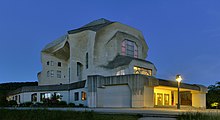Anthroposophical architecture
As anthroposophic architecture one is architectural approach referred to by the teachings of anthroposophy of Rudolf Steiner oriented. Time-bound elements of Art Nouveau and Expressionism can be recognized in their design means . The style of anthroposophical architecture is also to be understood as organic architecture .
description
The design of the buildings is based on the anthroposophical teaching that forms in nature follow the laws of nature and convey their content. For this reason, the buildings appear to be modeled on the forms of nature. Stylistic features are rounded organic shapes, but also geometric shapes such as the Duldeck house (two rectangles placed one inside the other). The roof is partially designed as a shell or cap, inside natural colors are used as glazes and materials such as wood. Anthroposophical architecture plays a major role in the design of interiors.
Well-known structures

The first and second Goetheanum in Dornach near Basel are fundamental models of anthroposophical architecture . After the first Goetheaneum was burned down by arson on the night of January 1, 1923, Steiner designed the second Goetheaneum, this time not out of wood, but out of reinforced concrete . The often twisted surfaces and the large spans presented themselves as a challenge for the statics and the formwork construction. Inside there are large rooms with a peculiar character due to the extensive renunciation of right angles, but which Steiner († 1925) no longer planned or planned have been established.
Michaels Church in Hamburg-Blankenese
The anthroposophical architecture is used particularly in the design of Waldorf schools and churches. For example, the main entrance to the Herdecke community hospital, which opened in 1969, was built in this style.
literature
- Sonja Ohlenschläger : Rudolf Steiner (1861–1925). The architectural work . Imhof, Petersberg 1999, ISBN 3-932526-37-6 (= Diss. Bonn 1991).
Web links
Individual evidence
- ^ Wilfried Koch: Architectural Style . Bertelsmann Lexikon Verlag, 2003, ISBN 3-577-10457-0 , p. 383 .
- ↑ Archived copy ( memento of the original from July 25, 2008 in the Internet Archive ) Info: The archive link was inserted automatically and has not yet been checked. Please check the original and archive link according to the instructions and then remove this notice.
- ^ Microsoft Corporation: Microsoft Encarta Professional 2008, Article: Anthroposophical Architecture
- ↑ Marco Bussagli: What is architecture . Kaiser Verlag, 2003, ISBN 3-7043-9017-8 , pp. 172 .



